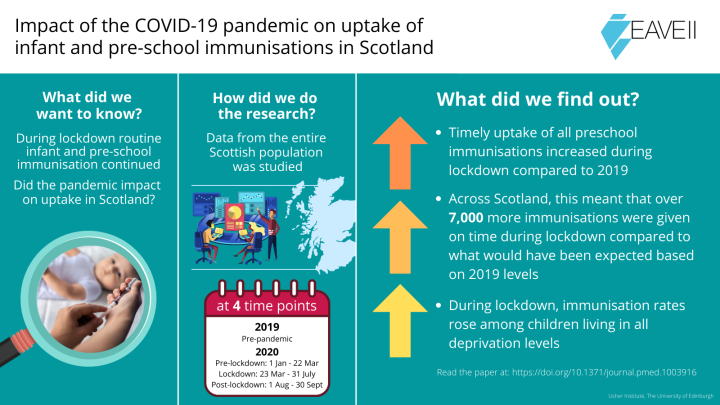Lockdown boost for kids’ vaccination rates in Scotland
Childhood vaccination rates significantly increased in Scotland during the first lockdown compared with the year before the pandemic, according to new research.
A slight decrease in numbers was also detected for uptake of vaccines in England for the same period, March to July 2020.
Experts say more research is needed to understand what factors potentially affected the increase in Scotland to help guide future vaccination programmes.
The WHO had raised concerns that limited access to health services at the start of the pandemic would lead to a fall in childhood vaccination rates.
To investigate this researchers from the University of Edinburgh and Public Health Scotland analysed routine heath data, which included the number of vaccination invites sent and appointments attended.

Changes in uptake
The team found a 14.3 per cent increase in children receiving the second dose of the MMR vaccine on time during the first lockdown in Scotland compared with vaccination levels in 2019.
Timely uptake of the third jab of the ‘6-in-1’ vaccine, which requires three doses to protect against many childhood diseases including whooping cough, increased by 9.1 per cent in Scotland.
The overall increase in vaccination equates to an additional 7,508 pre-school vaccinations being delivered on time during the lockdown compared with the same period in 2019.
In England, data were only available for the first dose of MMR, which had a fall of 1.92 per cent in uptake. There was also a 2.1 per cent decrease in uptake of the third dose of the 6-in-1 vaccine.
Influences
Experts say that due to the observational nature of the research it is not possible to definitively explain why these changes happened. They also advised against direct comparisons between Scotland and England because of differences in the datasets analysed.
The team, however, suggest that there may be several factors linked to Scotland’s boost in vaccination rates during lockdown.
One possibility is that furlough or more flexible working due to childcare commitments made it much easier for parents to attend vaccination appointments.
Other suggested factors were easier to access vaccination centres or mobile centres for those who were shielding and direct communications with families to remind them of their upcoming vaccination appointment.
This analysis was carried out as part of the EAVE II study, which uses anonymised linked patient data to track the effect of the pandemic on the healthcare system in Scotland. The findings have been published in the journal PLOS Medicine.
It’s encouraging to find that more children under five received their vaccines on time during lockdown, despite concerns that uptake might fall. It’s important that we continue this research to find out why this happened and how we can continue to encourage high immunisation rates to ensure children remain protected against many infectious diseases.
The study was funded by the Medical Research Council, UK Research and Innovation Industrial Strategy Challenge Fund, the National Institute for Health Research and Health Data Research UK (HDR UK), and was supported by the Scottish Government.
Additional support was provided through the Scottish Government Director-General Health and Social Care, and the UKRI COVID-19 National Core Studies Data and Connectivity programme led by HDR UK.
Related links
Paper published in PLOS Medicine

